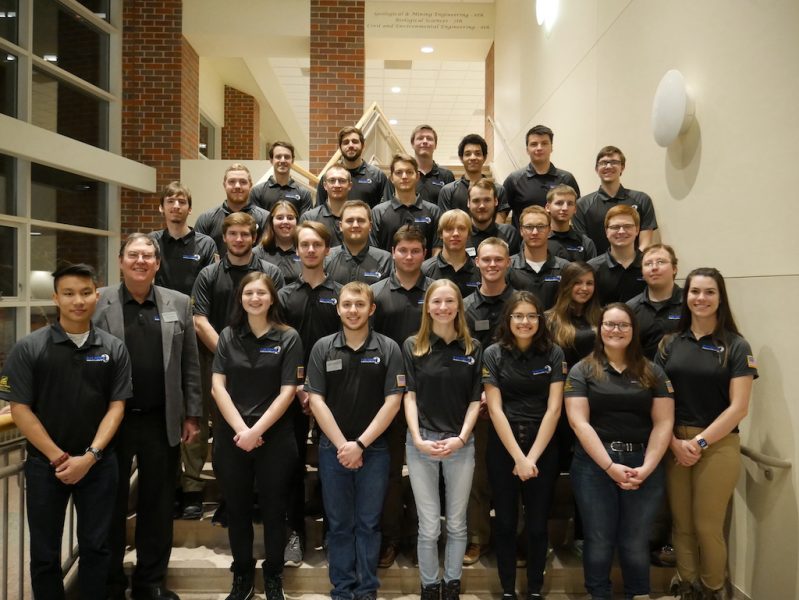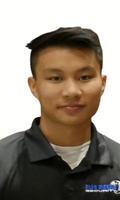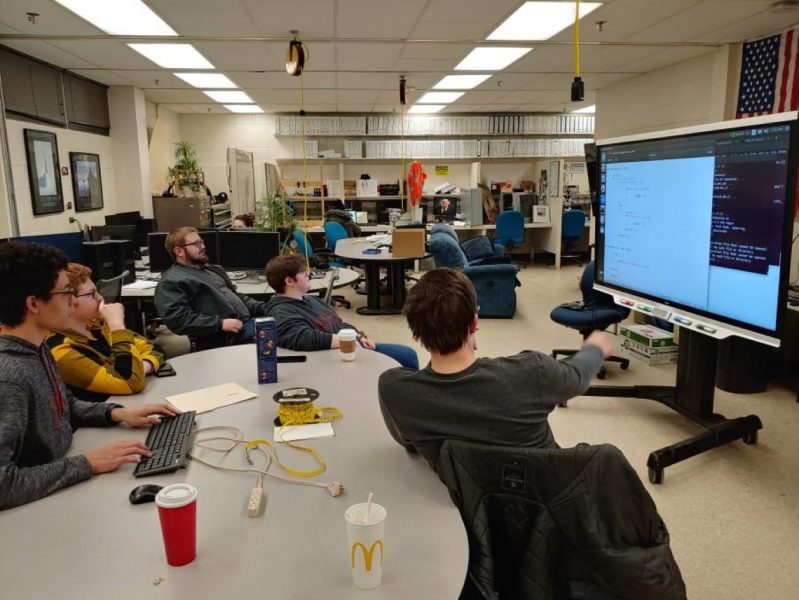What to do if you’re a computer engineering major and have plenty of math credits from high school?
If you’re Drew Rosales, you add an applied mathematics major, Blue Marble Enterprise, use your love of coding to help a PhD student conduct his research, and co-op for 10 to 15 hours a week. This Husky knows all about personal and professional exponential growth!
Drew is from Ann Arbor. He chose Michigan Tech because he relished the chance to try something different, get away from his hometown with a few friends, and be more independent. Experience a different part of the world. Drew likes the personable campus and class sizes. “I love the level of bonding here,” he says. “It’s not cutthroat.”
Drew has always enjoyed the engineering process. He’s been competing in Vex Robotics
since middle school, programming and building robots to perform tasks. He’s always been interested in mathematics. Coursework in linear algebra and differential equations helped him to better understand how space and time functions worked and how they relate to the world around us. He found he could use math to describe how objects move through the air and how different variables like drag and torque impact the robots he worked with. The robot improved through increased knowledge of how to manipulate sensor data and control algorithms — a great intersection between math, computer science, and physics. Applied math seemed like a perfect addition to computer engineering. Looking at the influence of mathematical techniques on computer algorithms added excitement to Drew’s studies.
One of his favorite courses is numerical partial differential equations (NPDE). He worked with a group to make a finite element analysis (FEA) tool to create a virtual mesh around a real-world product. The mesh allows the group to use math to show how different forces might impact the product. For example, think about a bridge subject to stressors like winds, tides, and weight-bearing. The tool makes it possible to select the optimal designs and materials for essential project specifications and conditions well before production.
“In NPDE I gained insight into how to use the tool and work with group members. It really was a point at which my two worlds of coding and mathematics (came together).”
“Research is fun,” says Drew, who’s grateful he’s been able to acquire valuable research experience as an undergrad. He enjoys writing code to support PhD student Praveen Hettige and Professor Ben Ong’s research to find structure in data using Geometric Multi-Resolution Analysis (GMRA). Drew reads academic papers — an art in itself — on GMRA, which is an approach for taking large amounts of high dimensional data and approximating it using affine hyperplanes (think line segments used to approximate a curve) enabling the data to be more easily stored and accessed. He grapples with challenges like creating data representations that can be easily interpreted as well as streamable and applicable to different scientific and engineering domains.
Praveen says Drew is a fast learner who’s up to the task. “In order to complete the coding parts, it’s necessary to have a basic understanding of the theoretical concepts about my research topic,” said the PhD student, who completed his master’s work in statistics at Michigan Tech. “ caught up with those concepts quickly.”
The research is aimed at taking data efficiently in smaller quantities instead of one big dump. Doing so makes it easier to process and analyze the information, reducing computation time and allowing data-based decisions to be made much faster and more efficiently.
Working on Real-World Projects with Michigan Tech Enterprise
Drew is also a member of Michigan Tech’s Enterprise program, serving as president of Blue Marble Security, a virtual company focused on industry-sponsored R&D and commercial product development including security, the environment, and industrial process control. The team is currently involved in seven multi-disciplinary projects, from smart tow capability for the US Navy to vision sensing for General Motors. In addition to his leadership role, Drew is doing coding and engineering work for the Navy project. Drew’s presidential duties include making sure the teams are progressing in their projects and have the resources they need to be successful. He assists teams in assessing timelines and tasks, is the point person for check-ins with Glen Archer, project sponsors, and keeps the Board informed. “Blue Marble has been instrumental in building my leadership skills. I have to assess how the team is doing and determine how to respond,” Drew says.
Archer goes a bit farther in assessing Drew’s skill. “One of Drew’s strengths that I have come to really appreciate is his calm approach to events around him. He is pretty much imperturbable. Drew is also resolute in his pursuits. He has risen steadily from a project engineer to project manager to the most senior leader in the organization. “
“It’s a pleasure to work with him because I know that if I ask him to do something, he will ask the questions he needs answered in order to do a good job. Once he has the answers, he will not fail to complete the task.”

A Co-op with Caterpillar Builds Skills and Confidence
In addition to classes, research, and Enterprise, Drew works as a co-op student for Caterpillar for 10 to 15 hours per week, a stellar addition to his engineering portfolio. His primary role has been to develop software for engine system sensors and to integrate the sensors into existing software. Drew conducts simulation testing on software for engines, validating that an engine reaches fuel efficiency guidelines and standards. The software allows Caterpillar to validate engine functionality before producing an engine en masse.
The work he’s put into presentation skills during his co-op has built confidence as well as a vision of what a bright future looks like. “I’ve learned more about how a full-time job works, how to work with others in a corporate setting, and what is expected of me on the job,” Drew says. “In addition, I have learned how to prepare myself while in college, building the skill set I need to be successful in my future career.”
Q&A on Drew’s Past, Present, and Future
Q: What have you learned about yourself and what advice would you give your high school self now?
DR: A lot of the time I see myself working on a task that might seem irrelevant or boring and tedious at the time, but it does come together, in the end, to be important. In college, with everything I have done, I’ve gained the ability to think about how to get better. Where are the gaps in knowledge I need to fill in and how do I go about doing it? It goes back to the dualities I’ve encountered between math and engineering, industry, and research. How can I grow and find value out of present and future opportunities? How does this influence what I find interesting and learned thus far?
Before college, I was more shy. Not as well-spoken. I always felt things would come together and fall into my lap. College helped me to see that I needed to be proactive, take initiative and make things happen. That breeds confidence. You would be surprised with the opportunities that you come across through networking, being bold, and sticking to your passions.
Q: Where do you go from here?
DR: I’m switching to a research role this summer doing predictive modeling with autonomous vehicles and possibly putting my GMRA research experience into practice. I plan to continue working at the intersection of math and computer science and putting research into practice. Eventually, I hope to go to graduate school.

